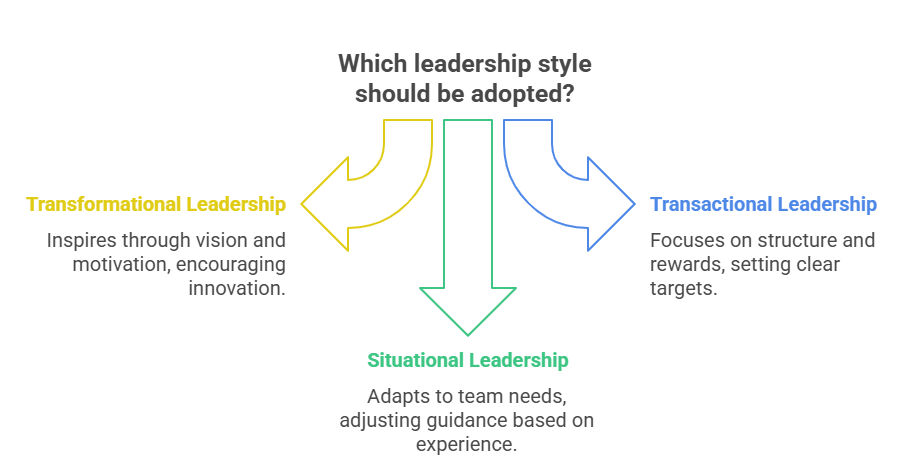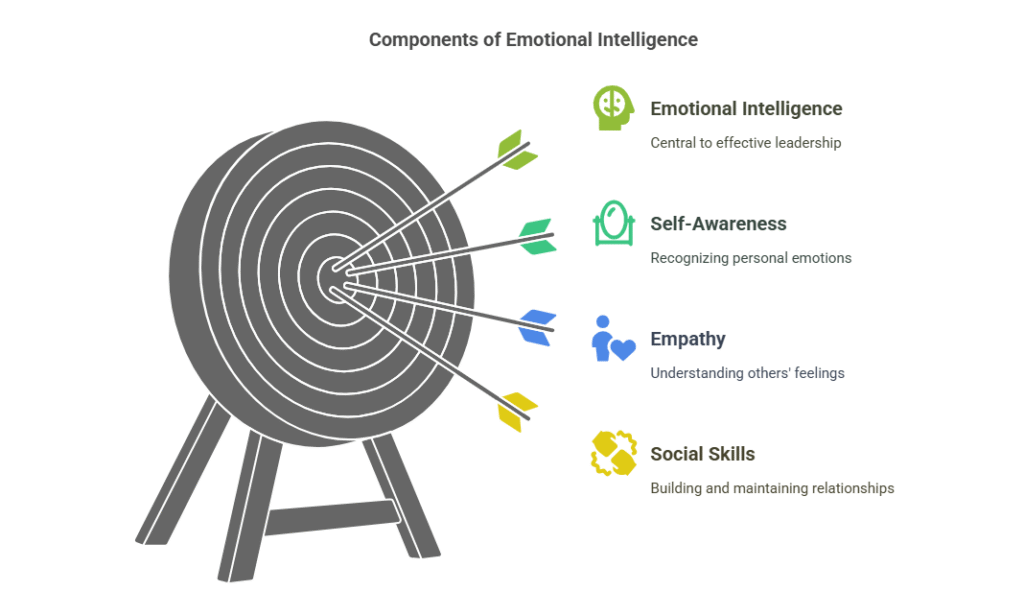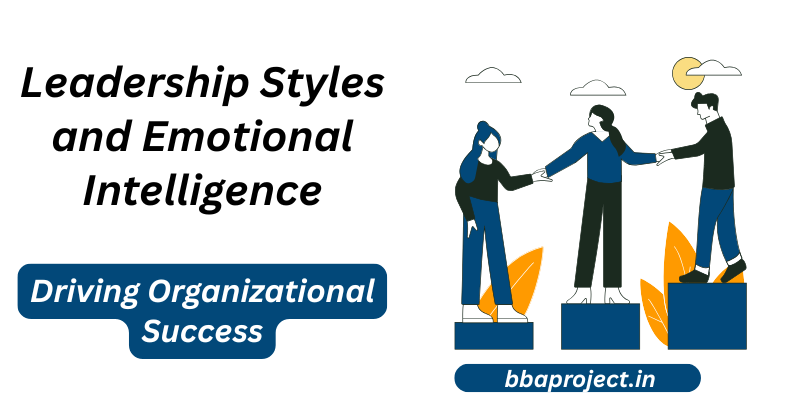Leadership Styles and Emotional Intelligence: Effective workplaces, engaging employees and organizational success can flourish with strong leadership and high levels of emotional intelligence. These concepts are necessary to study HR& OB exams as well as to prepare for students one step ahead of the campus placements and leadership roles in today’s business world. When intuitive leadership styles are combined with emotional awareness and reaction from emotional intelligence the result can empower managers to motivate teams, resolve conflict and drive productivity. This article includes coverage of different leadership styles, issues relating to emotional intelligence and how they impact on the organization This comprehensive guide provides detailed examples that apply theory to practice, exam focused tips and revision exercises that will help you put your academic knowledge into practice so that you perform better in your exams.
Understanding Leadership Styles
Leadership styles are distinctive ways by which a manager tries to direct and motivate the members of organization. In this competitive world of business in India, where teamwork and flexibility are essential, there is a lot to prove that effective leadership will make a huge difference in employee’s satisfaction and performance. For example, a manager at a service organization might adopt an innovation-friendly style in order to keep pace with competitors, capturing the variation of Indian workplaces.
Leadership is not the same in every situation; there are styles that work best for you under various conditions. A production company under tight deadlines may need a directive leader, a creative agency is likely to do better with the participative one. By knowing these styles, managers can harmonize their management style with the mission of their organization, and they can do so to ensure its success.
Key leadership styles include:

Transformational Leadership: Motivates employees with a vision and encouragement, just as a manager gets his or her team to continue creating new products.
Transactional Leadership: Emphasizes structure and rewards, like a manager assigning specific sales goals to the sales team.
Situational Leadership: Responds to the needs of a team, as if you might provide different guidance depending on how much experience an employee has.
Emotional Intelligence and Its Components
Emotional intelligence (EI) describes an individual’s ability to perceive, understand and manage both personal emotions and the emotions of others in a way that contributes to better leadership. In Indian companies, having multicultural teams and stressful workplace conditions as the norm makes EI invaluable in terms of bringing about team cohesion and conflict resolution. In a retail company, for instance, an executive will use emotional intelligence to relate to employees dealing with customer complaints in order to maintain employee morale and improve customer service.
Created by Daniel Goleman, EI comprises several factors that contribute to the success of an organization. Self-awareness helps leaders identify their own emotional triggers to make rational decisions. Empathizing with employees allows managers to experience a connection and build trust with their team members. They enable leaders to deal with challenges in the workplace with emotional maturity and be seen by others as assets to make a healthy work environment.
Central aspects of Emotional Intelligence are:

Self-Awareness: The ability to recognize one’s own emotions, such as when a manager pauses to think about how stressed she is before a meeting.
Empathy: Taking on the feelings of others, for example when a leader deals with an employee’s fears.
Social Skills: Relating to relationships and, say, acting as a mediator among teammates for a supervisor.
How Leadership Styles and Emotional Intelligence Drive Organizational Success
Leadership Styles and Emotional Intelligence on Organizational Success
The juxtaposition of leadership styles and EQ is an integral contributor to the success of any organization. For example, transformational leaders use EI as a tool to motivate teams by connecting their vision with their employees’ dreams. A manager at a consultancy firm could inspire employees by rewarding their contributions, increasing engagement. On the other hand transactional leaders use EI to communicate vision and goals clearly while empathizing with employees’ needs, maintaining control without losing their team.
What it does in practice is allow a leader to situate their style according to the demands of the moment. For example, take a firm in the service industry that has to meet a project deadline. A leader who is strong in EI, for example, can move from a directive to supportive style of leadership, where he or she takes the younger members of their team by the hand and supports them while letting more experienced personnel take charge. This adaptability boosts productivity and encourages a team culture, which according to sources such as SHRM is something India values.
And EI helps leaders guide their way through workplace diversity. A manufacturing company, a manager who is good in social skills but weak in technical skills brings harmony among team members from various backgrounds. When managers marry their leadership styles with emotional intelligence, they establish working conditions in which employees feel respected and valued – leading to performance and organizational success.
The impact of leadership styles on oral and written communication, and the implications to business.
The effects of leadership styles and emotional intelligence on businesses are far-reaching, such that they affect employee morale, productivity and overall organizational image. Successful leadership via EI makes an environment in which staffs are motivated to do their best. For example, a transformational leader in a retail company motivates staff to achieve beyond sales targets by rewarding job efforts, increasing job satisfaction and customer service quality.
From an economic point of view, leaders’ styles and emotional intelligence are associated with organizational effectiveness. As a result, an empathetic leader in a trading company settles supplier conflicts quickly and ensures the smooth operation and lower costs. Likewise, EI-based leadership engenders trust among stakeholders, including prospective employees and customers.
Table: Business Implications of Leadership and EI
| Implication | Economic Benefit | Practical Challenge | Exam Tip |
|---|---|---|---|
| Improved Productivity | Higher output and efficiency | Balancing motivation and pressure | Link to leadership styles in theory |
| Enhanced Morale | Lower turnover costs | Addressing diverse needs | Discuss EI in viva |
| Stakeholder Trust | Attracts talent and clients | Maintaining consistent EI | Cite examples in cases |
| Organizational Reputation | Competitive market advantage | Managing public perception | Explain benefits in descriptive |
Exam Tip: Link implications to economic outcomes (e.g., morale reduces turnover costs) in long answers.
Challenges in Implementing Leadership Styles and Emotional Intelligence
Effective leadership styles and emotional intelligence there are challenges in adopting effective leadership styles and emotional intelligence, understanding these obstacles (and how to overcome them) is essential to success. One of the main barriers is resistance to adaptive leadership. Workers within the manufacturing sector may resist a movement of a leader from a directive approach to one that is participative in nature for fear that structure will be lost. Leaders can address this by sharing the value of flexibility, including better collaboration and training to support employees in navigating the transition.
Developing emotional intelligence is, in turn, time-consuming and reflective. A service firm manager may find it difficult to empathize with their team members from different cultures. EI workshops through empathy and social skills, as pointed out by such resources as McKinsey, could help fill this gap. And let’s face it: Balancing authority and empathy can be tricky. When EI is low, a transaction leader who sets high goals risks alienating staff. Clear expectations; regular feedback sessions –> discipline with morale.
Global business settings present additional problems. A manager in an export company working with international teams may encounter different cultural perspectives on leadership. When referencing international EI frameworks as the CIPD there is an element of ‘one rule for all’ while still respecting local norms. These are solutions that can help leaders to apply leadership styles and emotional intelligence.
Team Dynamics and Motivation: Building High-Performing and Inspired Workforces
Practical Applications in Business
The application of leadership styles and emotional intelligence in real life can be seen across business sectors. In a retail organization, a transformational leader demonstrates EI by inspiring staff through the busy festive sales period and creates peak performance and customer satisfaction. Also, a Contingency leader in a consultancy firm who is able to flex his style in order to direct fresh employees whilst empowering existing staff thus enhancing project results.
These are all aspects where emotional intelligence really comes to the fore. A trader in a trading company settles the dispute between team members by listening with understanding creating peace without slackening of work. These also improve stakeholder relationships. For instance, a leader in a service firm fosters trust from clients by empathetically dealing with issues, which leads to longer-term contracts.
Suppose a corporation has low employee morale because it is putting pressure on employees to meet unreasonable deadlines. A high EI leader uses a transformational approach, motivating the team with an overall vision of success and emphasizing the individual. This inspires engagement, decreases turnover and leads to organizational success, evidence of the efficacy of fusing leadership styles with emotional intelligence.
Tips to Master Leadership Styles and Emotional Intelligence for Exams
In order to be very good in Human Resource & Organizational Behavior:
Examine the leadership styles (e.g., transformational, transactional, situational) and Ei components (e.g., self-awareness, empathy).
Describe how other companies have implemented EI and increased the effectiveness of their leaders on the job.
Refer to the table of provocative implications for quick reminder about advantages and challenges.
Check out SHRM for leadership tips and McKinsey for EI tactics.
Prepare for the viva by talking through leadership scenarios – dealing with team conflict etc.”
Conclusion
Leadership approach and emotional intelligence are important to successful organization performance and creating engaged teams in a trusting environment. Why Master Styles such as Transformational and Situational Leadership., and EI Components of Empathy and Social Skills. Transformational (Chew & Tang, 2014) ‚Situational (Northouse, 2016)‚ E.I.engkap making sure you succeed in your exams and Leadership! This book offers a route map for coaching the best of all possible leaders and will guarantee that you are ready to do academically well, communicate effectively and have room for positive emotional engagement in a career as a leader. Seek resources such as Harvard Business Review to enrich your knowledge and elevate your leadership.
👨💼 Author: BBAProject Editorial Team
✍️ The BBAProject Editorial Team comprises business graduates and educators dedicated to creating practical, syllabus-based learning resources for BBA students.
⚠️ Please Note: Articles published on BBAProject.in are well-researched and regularly updated. However, students are advised to verify data, statistics, or references before using them for academic submissions.

